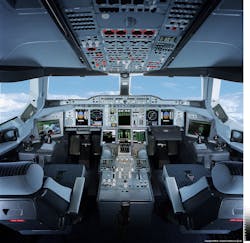Industry seeks new, rugged interfaces as electronics in aircraft grows exponentially
PHOENIX, 19 Jan. 2015. Legacy architecture is at its limit for aviation systems, says Michael Plannerer, head of development at MEN Mikro Elektronik GmbH in Numberg, Germany. The amount of electronic equipment in aircraft continues to increase, as does the need for new interfaces and rugged computer boards and systems for harsh, mobile, and mission-critical environments, he says.
Aircraft of the 1980s implement the ARINC-429 data bus; another standard still available is MIL-STD 1553 data bus, Plannerer explains. Aircraft today require more performance, on the order of 1000 times (1000X) the speed, bandwidth, and processing power compared to ARINC-429, he says.
Next-generation aviation interfaces will be based on IEEE 802.3 standard Ethernet technology, Plannerer predicts. It offers physical redundancy, safety, guaranteed bandwidth, deterministic timing, and virtual link communications.
The Airbus A380 commercial airliner, among the hottest and most advanced passenger jets on the market, takes advantage of Ethernet and MEN Mikro technologies. Specifically, Plannerer says, Airbus A380 takes advantage of nine Ethernet switches, connecting roughly 80 electronic systems in a mesh network, including flight control, cockpit, engines, energy, fuel and landing gear, and cabin.
Current aviation electronics, or avionics, solutions are still too large; the desire exists to reduce the size, weight, and power consumption (SWaP) of electronics throughout civil and military aircraft. A midterm solution is small, single-chip Avionics Full Duplex Switched Ethernet (AFDX) solutions replacing large PC systems. Long-term solution is the Internet of Things (IoT) in an airplane, Plannerer concludes.

